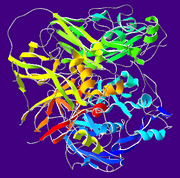A new method is described for the analysis of copper (Cu) containing ceruloplasmin (Cp) in human serum. The method uses immunoaffinity plus size-exclusion chromatography (SEC) to separate Cp from other proteins and from inorganic ions, with inductively coupled plasma mass spectrometry (ICP-MS) detection of 63Cu and 65Cu to identify the protein. An application note is available from Agilent.
Background:

Ceruloplasmin is the major copper-containing protein in plasma. The blue alpha-2 glycoprotein with a molecular weight of 132 kDa binds 90 to 95% of blood plasma copper (Cu) and has 6 to 7 Cu atoms per molecule. The various functions of this protein, although not fully understood, include ferroxidase activity, amine oxidase activity, superoxidase activity, and involvement in Cu transport and homeostasis.
The determination of ceruloplasmin is performed when disorders of copper metabolism or storage are suspected.
The most important clinical application of
the ceruloplasmin test is in the diagnosis of Wilson's disease,
where typically, concentrations of ceruloplasmin are reduced
and concentration of dialyzable copper are increased. Unless
treated with copper chelators, the disease is always progressive
and fatal. Prompt diagnosis is important since the treatment
takes 3-6 months to have the desired effect. Ceruloplasmin
assay should be considered in cases of central nervous system
disease of obscure etiology. Neurological symptoms include
problem of coordination.
Lower-than-normal ceruloplasmin levels may indicate:
- Menkes' syndrome (Menkes' kinky hair syndrome) -- very rare
- Wilson's copper storage disease (rare)
- Overdose of Vitamin C
- Copper deficciency
Greater-than-normal ceruloplasmin levels may indicate:
- Pregnancy
- Lymphoma
- Acute and chronic infections
- Rheumatoid arthritis
At present there is no standardized reference method for Cp, and the immunologic methods cross-react with apoceruloplasmin (apoCp), which can bias data and deliver higher than expected concentrations for the target protein.
The new LC-ICP-MS method: The method uses SEC to separate Cp from other proteins and from inorganic ions, and ICP-MS to detect Cu isotopes at mass-to-charge (m/z) ratios of 63 and 65 amu and to identify Cp using the 63Cu/65Cu signals. To eliminate possible interference from highly abundant proteins, some of which may bind Cu to form protein-Cu complexes, the serum sample is depleted of albumin, IgG, IgA, transferrin, haptoglobin, and antitrypsin using immunoaffinity chromatography prior to SEC. Quantification of the protein in the depleted serum is performed using external calibration with a Cp standard. Method accuracy and precision were established with a reference serum certified for Cp.
 Agilent Application Note:
Agilent Application Note:
Viorica Lopez-Avila, Orr Sharpe, William H. Robinson,
Determination of Ceruloplasmin in Human Serum by Immunoaffinity Chromatography and Size Exclusion Chromatography-ICP-MS,
Application Note, Agilent Technologies, 5989-5304EN, 2006 Related studies:
Related studies:
T.E. Machonkin, H.H. Zhang, B. Gedman, K.O. Hodgson, E.I. Solomon,
Spectroscopic and magnetic studies of human ceruloplasmin: identification of a redox-inactive reduced Type 1 copper site, Biochem., 37/26 (1998) 9570-9578.
DOI: 10.1021/bi980434v
Kazumi Inagaki, Naoko Mikuriya, Sayaka Morita, Hiroki Haraguchi, Yousuke Nakahara, Mamiko Hattori,Tomohiro Kinosita, Hidehiko Saito,
Speciation of protein-binding zinc and copper in human blood serum by chelating resin pre-treatment and inductively coupled plasma mass spectrometry, Analyst (London), 125/1 (2000) 197-203.
DOI:
10.1039/a907088e

Jose Joaquin Cerón, Silvia Martínez-Subiela,
An automated spectrophotometric method for measuring canine ceruloplasmin in serum, Vet. RFes., 35 (2004) 671-679.
DOI: 10.1051/vetres:2004046
Patrick J. Twomey, Adie Viljoen, Ivan M. House, Timothy M. Reynolds, Anthony S. Wierzbicki,
Relationship between Serum Copper, Ceruloplasmin, and Non-Ceruloplasmin-Bound Copper in Routine Clinical Practice, Clin. Chem. (Winston-Salem, N.C.), 51/3 (2005) 1558-1559.
DOI: 10.1373/clinchem.2005.052688
Viorica Lopez-Avila, Orr Sharpe, William H. Robinson,
Determination of ceruloplasmin in human serum by SEC-ICPMS, Anal. Bioanal. Chem., 386/1 (2006) 180-187.
DOI: 10.1007/s00216-006-0528-9
Kenji Kobayashi, Yoko Katsuya, Rizky Abdulah, Chie Fujisawa, Takeaki Nagamine, Akihiro Morikawa, Masami Murakami, Hiroko Kodama, Hiroshi Koyama,
Direct Analysis of Ceruloplasmin in Human Blood Serum by HPLC/Inductively Coupled Plasma-Mass Spectrometry for the Diagnosis of Wilson Disease,
Biomed. Res. Trace Elem., 18/1 (2007) 91-95. Related Information
Related Information
 Labtests Online: Ceruloplasmin
Labtests Online: Ceruloplasmin
 Related EVISA Resources
Related EVISA Resources
last time modified: July 3, 2025